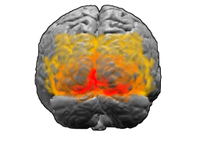
Photo from wikipedia
During resting-state EEG recordings, alpha activity is more prominent over the posterior cortex in eyes-closed (EC) conditions compared to eyes-open (EO). In this study, we characterized the difference in spectra… Click to show full abstract
During resting-state EEG recordings, alpha activity is more prominent over the posterior cortex in eyes-closed (EC) conditions compared to eyes-open (EO). In this study, we characterized the difference in spectra between EO and EC conditions using dynamic causal modelling. Specifically, we investigated the role of intrinsic and extrinsic connectivity—within the visual cortex—in generating EC-EO alpha power differences over posterior electrodes. The primary visual cortex (V1) and the bilateral middle temporal visual areas (V5) were equipped with bidirectional extrinsic connections using a canonical microcircuit. The states of four intrinsically coupled subpopulations—within each occipital source—were also modelled. Using Bayesian model selection, we tested whether modulations of the intrinsic connections in V1, V5 or extrinsic connections (or a combination thereof) provided the best evidence for the data. In addition, using parametric empirical Bayes (PEB), we estimated group averages under the winning model. Bayesian model selection showed that the winning model contained both extrinsic connectivity modulations, as well as intrinsic connectivity modulations in all sources. The PEB analysis revealed increased extrinsic connectivity during EC. Overall, we found a reduction in the inhibitory intrinsic connections during EC. The results suggest that the intrinsic modulations in V5 played the most important role in producing EC-EO alpha differences, suggesting an intrinsic disinhibition in higher order visual cortex, during EC resting state. Author summary One of the strongest signals that can be measured using EEG are so called alpha rhythms. These are neural oscillations that fall within the 8-12Hz frequency range. Alpha rhythms are most prominent when the eyes are closed and are seen at the electrodes placed at the back of the head. In this study, we studied the mechanism of alpha rhythms changes when going from eyes-open to an eyes-closed state. We used a biologically plausible model including different neural populations. We focused on modelling connections within and between different neural sources of the visual cortex and how they are modulated when going from eyes-open to an eyes closed state. We found evidence that inhibitory neurons play an important role in alpha rhythms.
Journal Title: PLOS Computational Biology
Year Published: 2022
Link to full text (if available)
Share on Social Media: Sign Up to like & get
recommendations!